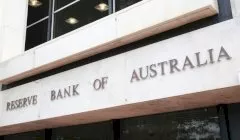Invest
Cash usage in Australia continues to decline as digital payments rise
In the ever-evolving landscape of financial transactions, Australia is witnessing a significant shift away from cash, as revealed by Worldpay's latest Global Payments Report. According to the report, cash usage in Australia has dramatically decreased from 67% of point-of-sale transactions in 2014 to a mere 14% in 2024. This trend is expected to continue, with cash projected to account for just 9% of transactions by 2030.
Cash usage in Australia continues to decline as digital payments rise
In the ever-evolving landscape of financial transactions, Australia is witnessing a significant shift away from cash, as revealed by Worldpay's latest Global Payments Report. According to the report, cash usage in Australia has dramatically decreased from 67% of point-of-sale transactions in 2014 to a mere 14% in 2024. This trend is expected to continue, with cash projected to account for just 9% of transactions by 2030.

Alison Morris, Senior Vice President and General Manager for Worldpay Platforms International, commented on these findings, highlighting the rapid adoption of digital payments across the nation. "These figures highlight the rapid adoption of digital payments," Morris stated. "But they also show that cash remains an essential part of daily life for millions of Australians, from older shoppers to regional communities and households that rely on it for financial independence."
Despite the decline in cash usage, it remains clear that cash still plays a crucial role in the financial ecosystem. For many Australians, especially those in regional areas and older demographics, cash is not just a payment method but a means of maintaining financial autonomy. This underscores the importance of preserving cash as a viable option for transactions, even as digital payments become more prevalent.
The report also sheds light on how consumer payment preferences have evolved over the past decade and the implications of this shift for small businesses across Australia. Morris emphasised that for small enterprises, the focus should not be on choosing between cash and digital payments but rather on offering a diverse range of payment options. "For small businesses, the choice is not about cash versus digital payments," she explained. "The real priority is offering a range of payment options. Cash and card payments complement each other, serving different customers and reducing friction at the checkout."
This approach is particularly relevant for businesses such as cafés, retailers, and gyms, where customer experience is paramount. Offering a variety of payment methods not only enhances convenience but also serves as a strategic advantage in a competitive market. "Cafés, retailers, gyms/wellness studios and other small businesses that embrace a mix of payment methods are best positioned to build customer loyalty," Morris noted. "Offering a variety of payment options from cash to contactless and newer solutions like PayTo is not just convenient; it is a competitive advantage. Businesses that make it easy for every Australian to pay are the ones customers keep returning to."

The rise of digital payments in Australia is part of a broader global trend, driven by advancements in technology and changing consumer preferences. Contactless payments, mobile wallets, and online banking have become increasingly popular, offering speed and convenience that traditional cash transactions cannot match. However, the enduring presence of cash highlights the need for inclusivity in payment systems.
As businesses navigate this transition, the emphasis is on flexibility and adaptability. By accommodating a wide array of payment methods, businesses can cater to diverse customer needs and preferences, ultimately fostering loyalty and repeat patronage. This adaptability is particularly crucial in a post-pandemic world, where consumer behaviours have shifted, and expectations for seamless, contactless transactions have risen.
The decline in cash usage also poses challenges for certain segments of the population who may be less comfortable with digital payments. Ensuring that these individuals are not left behind in the digital economy is a key consideration for policymakers and businesses alike. Efforts to educate and support these groups in adopting digital payment methods will be essential in achieving a balanced and inclusive financial landscape.
While the decline of cash in Australia is a testament to the growing popularity of digital payments, it is clear that cash still holds a vital place in the economy. For small businesses, the strategy lies in embracing a comprehensive range of payment options to accommodate all customers. As Morris aptly put it, "Businesses that make it easy for every Australian to pay are the ones customers keep returning to."

Cash
Navigating the equilibrium: Investor sentiment in the face of equity peaks and diminishing cash reserves
State Street's latest Risk Appetite Index indicates a nuanced shift in institutional investor sentiment during March, with the index reverting slightly towards neutrality. This subtle recalibration in ...Read more

Cash
RBA's November rate hike overshadows Melbourne Cup festivities
In a move that managed to draw attention away from the thrill of the Melbourne Cup, the Reserve Bank of Australia (RBA) has increased the cash rate by 25 basis points to 4.35 per cent, surprising ...Read more

Cash
RBA makes first cash rate call for 2022
The RBA has announced its first rate decision for 2022. Read more

Cash
Cash remains king for many Australians
Demand for banknotes remains high despite a decline in cash transactions. Read more

Cash
Interest rates to rise next year?
Commonwealth Bank has seconded Westpac’s predictions, forecasting that interest rates will rise well ahead of the RBA’s 2024 timeline. Read more

Cash
RBA makes latest official cash rate call
The Reserve Bank of Australia has made its May call on the official cash rate, with the economy said to be a long way from the conditions needed to precede a rate rise. Read more

Cash
RBA puts chatter of an earlier rate hike to rest
The Reserve Bank of Australia has put to rest chatter among investors that conditions for a higher cash rate could be met as early as next year, reaffirming its stance that the rate is “very likely” ...Read more

Cash
Australia tipped to go cashless by 2024
Australia is forecast to effectively go cashless in just three years, with three in 10 Aussies admitting that “going cashless would be great for the country”. Read more

Cash
Navigating the equilibrium: Investor sentiment in the face of equity peaks and diminishing cash reserves
State Street's latest Risk Appetite Index indicates a nuanced shift in institutional investor sentiment during March, with the index reverting slightly towards neutrality. This subtle recalibration in ...Read more

Cash
RBA's November rate hike overshadows Melbourne Cup festivities
In a move that managed to draw attention away from the thrill of the Melbourne Cup, the Reserve Bank of Australia (RBA) has increased the cash rate by 25 basis points to 4.35 per cent, surprising ...Read more

Cash
RBA makes first cash rate call for 2022
The RBA has announced its first rate decision for 2022. Read more

Cash
Cash remains king for many Australians
Demand for banknotes remains high despite a decline in cash transactions. Read more

Cash
Interest rates to rise next year?
Commonwealth Bank has seconded Westpac’s predictions, forecasting that interest rates will rise well ahead of the RBA’s 2024 timeline. Read more

Cash
RBA makes latest official cash rate call
The Reserve Bank of Australia has made its May call on the official cash rate, with the economy said to be a long way from the conditions needed to precede a rate rise. Read more

Cash
RBA puts chatter of an earlier rate hike to rest
The Reserve Bank of Australia has put to rest chatter among investors that conditions for a higher cash rate could be met as early as next year, reaffirming its stance that the rate is “very likely” ...Read more

Cash
Australia tipped to go cashless by 2024
Australia is forecast to effectively go cashless in just three years, with three in 10 Aussies admitting that “going cashless would be great for the country”. Read more









